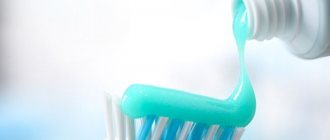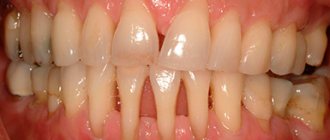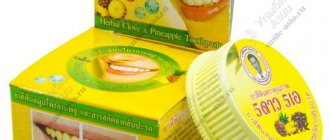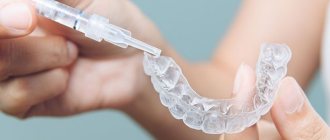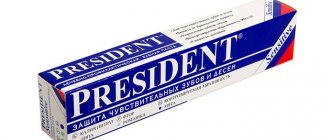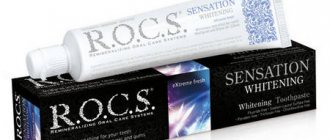Types and composition
There are 2 options for Colgate Elmex toothpaste - children's and junior. They are available in polymer tubes of 50 ml and 75 ml, respectively. The composition of the products is significantly different: the children's paste contains active substances and amino fluoride. It contains no preservatives, dyes or foaming agent sodium lauryl sulfate.
On a note!
Colgate Elmex children's toothpaste is intended for children aged 0 to 6 years. Colgate Elmex Junior is indicated for use in children and adolescents from 6 to 12 years of age.
Colgate Elmex Junior paste consists of several components:
- Calcium carbonate - ordinary chalk, which works as an abrasive and removes plaque well.
- Silicon dioxide (hydrated silica) is an abrasive substance that is perfectly compatible with fluoride compounds and other paste components. Its hardness can be controlled, resulting in products with a low degree of abrasiveness that do not damage tooth enamel. Silica plays an important role in ensuring normal acid-base balance in the mouth.
- Sorbitol is a sweetener that gives a sweetish taste.
- Sodium lauryl sulfate is a surfactant with high cleaning ability. It is this component that many pastes owe to their good foaming properties.
- Sodium and magnesium monofluorophosphate. They help strengthen tooth enamel and increase its resistance to aggressive acids and bacteria, and prevent plaque formation.
- Aluminum phosphate – mineralizing additive. In adolescents, enamel mineralization is not yet complete, and phosphates enrich saliva with phosphorus and actively participate in metabolic processes between saliva and tooth enamel. As a result, the buffer capacity of saliva increases, and the deficiency of the constituent elements of hydroxyapatite - the main “building material” of bones - is replenished.
- Cellulose gum – thickener, viscosity regulator.
- Sodium bicarbonate (soda), which removes plaque and polishes the enamel, increases the absorption of calcium by the enamel and strengthens it;
- Methyl (E218) and propylparaben (E216) – preservatives that extend the shelf life of the product;
- Limonene is a flavoring agent that imparts a pine or citrus aroma. It dissolves fat well and prevents microbes from developing.
Toothpastes for sensitive teeth from Italy Elmex and Biorepair
Hi all! The topic of toothpastes on Cosmetist evokes conflicting emotions, but I still decided to share my impressions of two products that I was advised to bring from Italy.
Please, if you are not interested in this topic, just skip this post, I will not be offended. Toothpaste as a product is at the intersection of personal hygiene, medical and cosmetic products. It’s difficult for me personally to talk about such products - I have a very superficial understanding of the issue of compositions and active ingredients and I sincerely believe that only a dentist can help you choose the right paste that’s right for you. But still, you must admit, most people just go to the grocery store and take the most popular/cheapest/prettiest thing off the shelf, because the task is simply to brush their teeth.
A little theory
You can safely skip this part.
I tried to systematize the knowledge gained after reading various articles, if you can add something, I will be glad to receive information in the comments. Tooth enamel is a strong framework consisting of 3% water, 1% organic matrix and 96% mineral inorganic compounds. Despite its strength, it is susceptible to abrasion and destruction under the influence of mechanical (for example, chewing solid food) and chemical (acids formed as a result of the reaction of consumed food and saliva) factors. If nothing is done, the enamel thins and becomes porous, opening the way for bacteria to penetrate, which can lead to tooth decay, various gum diseases, and tooth loss. Actually, toothpaste is used to strengthen the enamel, saturate it with minerals, prevent the accumulation of tartar and fight bacteria.
Many dentists argue that the fact of brushing your teeth is what matters most. For most people without serious dental problems, brushing your teeth 2 times a day for 2-3 minutes is sufficient. And if a problem exists, then you can already turn your attention to special-purpose pastes, but they can be used for a limited time and better under the supervision of a doctor.
The composition of different toothpastes is approximately the same:
⓵ The base of the paste is water mixed with glycerin and often sorbitol, which prevent the paste from spreading and the water from evaporating. ⓶ Abrasives: silicon oxide derivatives, mica or mineral salts, which are needed to mechanically remove plaque from tooth enamel. The greater the abrasiveness, the higher the risk of mechanical damage to the enamel. Highly abrasive pastes are used to whiten teeth; For teeth with increased sensitivity, it is better to choose a paste with a low abrasive content. Look for the RDA abrasiveness rating on the box (for sensitive teeth - no higher than 40). ⓷ Foaming agents - often sodium lauryl sulfate (SLS) or other, milder surfactants, help remove plaque when rinsing. Some people consider SLS to be a harmful ingredient, but in fact it should be avoided if you have an individual reaction. The abundance of foam is not an indicator of the effectiveness of the toothpaste. ⓸ Dyes: the most common is titanium dioxide to create a slight enamel whitening effect. An alternative is charcoal (remember black pastes?), it works as a mild abrasive, is safe and can be easily washed out with water. The bright color of toothpaste is achieved with food dyes and does not carry any meaning. ⓹ Flavorings and sweeteners - limonene and menthol, as well as food additives, give the effect of “frosty freshness” or a simply pleasant-tasting product. ⓺ Emulsifiers and thickeners - carrageenan, xanthan gum, sodium carboxymethylcellulose, magnesium aluminum silicate - so that the paste maintains its original thickness and does not separate. ⓻ Preservatives - methylparaben or sodium benzoate - prevent the formation and growth of bacteria in the paste itself and extend shelf life. ⓼ Antiseptics or antibacterial components that prevent bacteria from developing on the gums or under the film of plaque. Long-term use of antibacterial paste can lead to microflora disruption. ⓽ Additional components or special additives for specific purposes: - strengthening gums (chlorhexidine, plant extracts - echinacea, calendula, chlorophyll, tocopherol); - reducing sensitivity: covering the teeth with a protective shell (strontium, arginine) or dulling pain, gradually acting on nerve endings (for example, potassium nitrate or citrate); — enamel lightening: abrasive (see point 2, RDA 100-120), enzyme (papain, bromelain) and coloring (hydrogen peroxide or urea). ⓾ Components for restoring and strengthening enamel. Let's take a closer look at this.
There are 2 ways to saturate enamel with building material (or remineralize): stimulation of natural synthesis and delivery of the finished substance.
➤ For the synthesis of minerals, soluble calcium compounds are needed; for this, catalysts are added to toothpastes - fluorine compounds and a special pentaatomic alcohol xylitol. During brushing (and an hour or two after), under the influence of fluoride anion or xylitol, calcium passes from saliva into the enamel, thereby restoring the integrity of the structure. Now there are many articles on the topic of the harm of fluorides, but in fact their concentration in toothpaste is not dangerous and is controlled by manufacturers. The permissible content is 1500 ppm (0.15% fluorine ions). 4 most common ingredients: - sodium monofluorophosphate (Sodium Monofluorophosphate) - the cheapest component. The peculiarity is that after brushing your teeth with such pastes, it is better not to eat, drink or rinse your mouth for 2-3 hours to release fluoride ions from saliva. And if the composition also contains SLS, then there is a risk of reducing the activity of the component - tin fluoride (Stannous Fluoride) works faster than the first comrade, at the same time stopping the growth of bacteria, but has a side effect - staining tooth enamel yellow, although manufacturers have long been using additional components to neutralize this feature. - sodium fluoride (Sodium Fluoride) - works quickly and safely, at the moment the most common component of toothpastes. - aminofluoride/Olaflur (Aminofluoride/Olaflur) - an organic fluorine compound, has a very high remineralizing ability, creates a thin film on the surface of the enamel, which remains on the teeth even after brushing the teeth, which means fluoride will penetrate the enamel from such a film for a longer time.
Pastes containing fluoride are not recommended for use in children and adolescents, as well as in cases of fluorosis and in regions with high levels of fluoride in drinking water.
➤ An alternative method of remineralization is to deliver the substance directly to the tooth surface. To do this, they add, for example, hydroxyapatite (or hydroxyapatite, Hydroxylapatite) to toothpastes - a crystalline form of calcium phosphate, which actually makes up the inorganic part of tooth enamel. It has been studied for more than 50 years, is stable (does not decompose under the influence of temperatures, saliva and alkaline environment), safe for the body, biocompatible (perceived by cells as a related component), because of this it is widely used in surgery (promotes bone growth) and dentistry (for example , coating of implants to speed up implantation). Now it is also used in cosmetology, hygiene and body care products, and even dietary supplements with this component are produced to strengthen bone tissue. Hydroxylapatite is obtained from sea corals and cattle bones, but before conservationists raise their heads, the good news is that the component has been synthesized for a long time. It is a white fine-crystalline powder; added to toothpastes looks like a slightly transparent white substance capable of reflecting and scattering light. When brushing your teeth, it envelops the tooth, laying down with a thin, imperceptible film, giving the effect of whiteness and porcelain shine. It has a complex effect in several directions at once: - helps remove plaque (due to its high bioactivity, during brushing it “sticks” to bacteria and plaque particles, facilitating their rinsing from the oral cavity) - restores the smoothness of the enamel (acts identically to a filling, “bricking up” microcracks on the surface enamel, making it more resistant to bacteria) - replenishes the loss of minerals (provides missing minerals to damaged areas under the surface of the enamel, thereby restoring density). It is important to note here that enamel destroyed down to dentin or damaged by caries cannot be returned; remineralization works as prevention. — eliminates tooth sensitivity (gradually clogs the dentinal canals, thereby dulling the pain. According to the latest data, it only takes a week for results). All these functions apply only to spherical hydroxyapatite nanoparticles (reduced to the level of organic compatibility), larger ones (even crushed to the micro level) will work as a simple abrasive. The catch is that when certifying a product, the manufacturer is not required to confirm the particle size, indicating only the quantity in the composition. Research continues and so far all the results boil down to the fact that nano-hydroxyapatite is as effective as fluorides, but is safe even for children. In Japan, the component is approved and actively used, but in Europe, regulatory authorities can neither confirm nor deny the absolute safety of the component, and for now the recommended amount of pure nanoproduct in toothpastes is 10% (full text in English), and it is better to avoid using such pastes for bacterial damage to the gums. And scientists continue to offer new versions of the component with various compounds and modifications. Synthetic nano-hydroxyapatite is not the only bioactive source of calcium; at the moment there are analogues with an identical pattern of action: calcium nitrate phosphosilicate (NovaMin bioactive glass), amorphous calcium phosphates (ACP) or their compounds (for example, Recaldent - CPP-ACP with casein -phosphopeptides).
In addition, there are also toothpastes from “green” sites, but I’d rather ignore this topic.
I have relatively problem-free teeth, but by the age of 30 I managed to get implants. There is a tendency to form a wedge-shaped defect (no need to Google, the photos are unpleasant, in fact it is erosion of the enamel in the cervical area of the tooth), accompanied by increased sensitivity. I don’t smoke, I drink tea and coffee in moderation (1-2 cups a day), but I can’t give up sweets and lemons. As a standard, I brush my teeth 2 times a day with an electric brush, choose a toothpaste for sensitive teeth, plus dental floss. Once a year I undergo professional dental cleaning followed by remineralization. For the last 8 years I haven’t thought about sensitive teeth, because... On the advice of the dentist, I used Sensodine paste, just changed different types. But some time ago I decided to take a whitening solution and after 2 weeks I experienced an aggravation of sensitivity: my teeth not only reacted to the air with acute pain, but also constantly ached, adding to the discomfort. At that time, I remembered the discussions in the comments to posts about toothpastes on Cosmetist and, while in Italy, I purchased two different ones - for sensitive teeth.
Today I just want to share my impressions of using them. I applied one after another, took a two-week break between them, returning to the old paste - for the purity of the experiment. Let me remind you that I am not an expert, much less a dentist, so my review is based on my own feelings and the cosmetic effect of the pastes.
Paste for sensitive teeth Biorepair Plus Sensitive Teeth
Biorepair
brand belongs to the Italian company
Coswell
, which supports innovative technologies, has its own production and laboratory and collaborates with the University of Bologna (the oldest in Italy and Europe, where Nicolaus Copernicus, Luigi Galvani, Enzo Ferrari and Giorgio Armani graduated).
The company is a family-run company that produces consumer products: cosmetics (shower gels and deodorants, as well as Transvital facial care products), perfumes, herbal teas and dietary supplements, as well as insect sprays. The pharmaceutical division produces products in the mass market segment - Biorepair
, which can be found on the shelves of even grocery stores with an appropriate price tag. In addition, BlanX teeth whitening systems and products for dental offices Rapident and Stomygen are produced (there are also products for fillers in cosmetology).
Biorepair toothpastes
— absence of fluorides in the composition.
An innovative development is used as the main remineralizing component: zinc-substituted carboxyhydroxyapatite (trade name microRepair
), essentially a chemically modified version of hydroxyapatite, where calcium is replaced by zinc ions, which stimulate collagen synthesis, accelerate the process of bone tissue formation, have antibacterial properties, This preserves the properties of nano-hydroxyapatite. This method made it possible to achieve a minimum particle size of (nano) flake shape without increasing the cost. The resulting patent (full text in Russian) smoothly bypasses European restrictions.
Biorepair Plus
- medical products, intended to treat specific problems, contain a higher dose of the active drug, but can be used on a daily basis.
The packaging is a standard cardboard box with a lot of information, I have the version for eliminating tooth sensitivity.
Easy to open
Standard volume: 75 ml, enough for 2-3 months of daily use 2 times a day. Retail price (and in the official online store of the brand) is 4 euros.
Soft plastic tube
with screw-on corrugated lid
The dispenser opening is initially protected with foil
Free of SLS, parabens, fluorides and titanium dioxide, non-abrasive formula (RDA = 14.7)
If we look at the composition in more detail: - Standard water (base) + glycerin + sorbitol (prevents drying out and gives a sweetish taste to the paste) - Zinc hydroxyapatite ( microRepair
) is the main active component, a remineralizing agent, in an amount of 24% by weight. It should also be responsible for antibacterial and hypersensitivity-reducing functions. — Thickeners — cellulose resin and PEG-32 — Silicon dioxide — a mild abrasive — Sodium myristyl sarcosinate and methyl cocoyl taurate — mild surfactants that help water mix with food debris and mechanically cleaned plaque for easy rinsing — Sodium saccharinate — sweetener, food flavorings are also added — Citric acid is a regulator of the acidity of the mixture so that the paste does not irritate sensitive gums and mucous membranes — Phenoxyethanol, benzyl alcohol and sodium benzoate are preservatives
Based on the analysis of the composition, our knowledge of hydroxyapatite and the manufacturer’s promises, the following picture emerges: thanks to the increased content of bioactive components ( microRepair
) nanoparticles related to the enamel structure bind to the natural hydroxyapatite of enamel and dentin, penetrate microscratches, block dentinal tubules, thereby dulling sensitivity, and create a protective layer on the surface of the enamel, which remains in place for 24 hours and reliably protects against an aggressive external environment. Let me remind you that there are no components in the composition that instantly relieve pain, and hydroxyapatite begins to work in full force only after a week. In my case, my expectations from the paste were initially too high, because... I didn’t understand the composition at that time (and I didn’t know much about it), but I needed relief from pain here and now.
The pasta came with an information sheet with a description in Italian and English
lists all released products of the brand
The paste itself is white, thick, creamy, medium density, squeezed out of the tube with a thick sausage. To brush your teeth you only need a pea, but because of this consistency, I subconsciously try to squeeze out more, since the size of an electric toothbrush is limited
Standard smell of sweetish minty chewing gum. When cleaning, the paste is very pleasant: it hardly foams (I’m used to this in toothpastes for sensitive teeth and for me this is the norm), mild in action (due to low abrasiveness), feels like a cream, does not irritate or sting the mucous membranes, tastes like sweet mint, which remains in the mouth for a long time, giving a fresh effect. When girls wrote in reviews about the smoothness of their teeth, I chuckled skeptically - all toothpastes have approximately the same cosmetic effect. But it was worth trying for yourself and I must note that I was wrong: the paste really seems to envelop the teeth, laying down with an imperceptible film, thereby imparting smoothness and a moist shine. Touching your teeth with your tongue is extremely pleasant, no roughness at all. With standard brushing 2 times a day, the effect is really different from many regular toothpastes, where by the end of the day you can already feel plaque on your teeth. Here the effect of hydroxyapatite is evident, which visually makes the teeth a little whiter and the enamel smoother and more even. From the point of view of cosmetic (visual) effect and ease of use, the paste is truly ideal.
But getting rid of sensitivity is mediocre. I repeat once again, my expectations were too high, but you must admit that when all your teeth ache so much that it is impossible to sleep, and especially sensitive places closer to the gums react with sharp, stinging pain when breathing, it is difficult to talk about patience. I expected quick relief from acute pain, as indicated by the manufacturer on the tube. But in my case, my teeth stopped aching only after a week (yes, I kept a diary and noticed every change), but the acute reaction in the cervical area, where my teeth are prone to wedge-shaped defects, did not go away even after 2 months while I was using pasta. If this were my first toothpaste for sensitive teeth, then I would sincerely believe that my fate was to put up with eternal pain, but having many years of experience behind me using other toothpastes for similar purposes, I prefer not to hurt, even if I have to spend your entire life on “dopings” that instantly mask pain.
To talk about protection against caries, you need to use the paste for several years and notice changes, but after two months I can only draw preliminary conclusions: the paste really prevents the accumulation of plaque, visually makes the teeth smooth, and a slight whitening effect has been noticed. No caries appeared during this time, but in general I have no problems with it. The paste, alas, did not cope with hypersensitivity, but in fairness I can say that the teeth stopped whining and after stopping the paste the situation did not worsen.
Still, I don’t want to take on the responsibilities of a dentist and recommend or, on the contrary, dissuade you from buying this paste, but if you have problems similar to mine, then the result will be approximately the same. If it is important to you how pleasant the paste is to use, feel free to take Biorepair
, positive emotions are guaranteed to you. As for the main function of toothpaste - quickly eliminating sensitivity, I would rather use this paste not in moments of sharp exacerbation, but as a support, or alternate with a paste with the effect of instant relief from pain. For everyday use it is quite ok.
Country of Origin:
Italy
Price:
500-600 rubles in Russia and 4 euros in Europe.
This paste is a product of the mass market segment, in Europe its cost is identical to standard pastes, but in Russia the price is clearly overpriced (plus the exchange rate affects), it is definitely not worth the money. Testing period:
2 months 2 times a day
Rating:
5 out of 10, quite a pleasant paste, but without a therapeutic effect
Paste for sensitive teeth Elmex Sensitive Professional
Elmex
toothpastes are produced by
Colgate-Palmolive
(I hope it doesn’t need an introduction) for the European market, sold not only in Italy, but also in other countries of Central and Eastern Europe. The products are recommended by dentists (like many others, in principle), there are 4 lines: for children, protection against caries, for sensitive teeth and strengthening enamel. In the line for sensitive teeth, I counted 6 different toothpastes - for a specific problem.
My version (bought at random, by the way) is a medical toothpaste for immediate and long-term pain relief on pain-sensitive teeth. Remineralization is achieved by adding fluoride in the standard permitted concentration plus the addition of pro-Argin
(developed by Colgate) to relieve pain.
The same technology is used in Colgate Sensitive Pro-Relief
.
Packaging is standard cardboard, although all information is in Italian
To open, you need to tear off the end
Volume: 75 ml, standard consumption - enough for 2-3 months of daily use 2 times a day. The price is relevant to standard pastes in the mass market segment - 4-5 euros (I got it at a discount from the original price).
The tube looks the same as that of the first hero of the post - soft plastic
and screw-on corrugated lid
Plastic gear protection, to remove you need to use a special recess in the cover
Contains:
— Base — water + sorbitol — Sodium monofluorophosphate (fluoride concentration 1450 ppm) — the main remineralizing component — Arginine (at a maximum concentration of 8%) — a natural amino acid that can neutralize acids and, in combination with calcium carbonate and sodium monophosphate, forms insoluble compounds that seal dentinal tubules and block pain signals. The manufacturer allows 2 weeks to create a durable protective barrier and relieve pain. — Calcium carbonate (chalk) is an abrasive, a supplier of calcium for remineralization and a direct participant in the pro-Argin technology. - Soda - an abrasive and light whitening - Sodium lauryl sulfate - as a foaming component - Thickeners - cellulose resin, sodium pyrophosphate and xanthan gum - Titanium dioxide - a bright white substance, deposited in microcracks and roughness of the enamel, creates an optical effect of brightening the teeth, is quickly washed out. — Sodium saccharinate is a sweetener, food flavoring and limonene are also added for flavor — Benzyl alcohol is a preservative
The composition raises questions for me, it is not much different from standard Colgate, the combination of fluoride + calcium is quite controversial, and the level of abrasiveness according to the network = 65
The paste is grayish-white in color, dense and somewhat dry in appearance, with small inclusions. Standard consumption
The smell is peppermint, slightly medicinal. When brushing your teeth, it foams slightly, rather turning into a semi-liquid emulsion, without pronounced bubbles, but due to the dryish texture you have to first brush the paste in your mouth in order to distribute it normally. It tingles the mucous membrane a little, but does not burn, the taste is standard mint. After cleaning, you get that same feeling of “frosty” freshness. The teeth are smooth, but without lasting results, although it lasts me until the next cleaning. No whitening effect was noticed, although due to abrasive particles it removes plaque well.
Getting rid of hypersensitivity comes gradually, but the paste never completely copes. Initially it was a little easier for her - my teeth no longer ached, but the reaction to cold air persisted, Biorepair
. Over the course of about two weeks, the pain became less, it was no longer felt so sharply and did not throb, but simply pricked with a needle and went away abruptly, but even after 2 months of using the paste, the teeth did not lose sensitivity completely. Again, this effect is already good for some, but I’m used to not feeling pain at all. Perhaps with long-term use one could talk about a better result, but I was frankly unpleasant to use this paste due to the dryish texture and tingling of the mucous membrane. It is also difficult to talk about the prevention of caries and complete removal of dental plaque; you need to look at the results of several years.
As a result, the pasta turned out to be ordinary everyday pasta, of which there are millions on the shelves. I don’t see any point in specifically chasing it, much less buying it at an inflated price.
Country of Origin:
Poland
Price:
4-5 euros in Europe.
Testing period:
2 months 2 times a day
Rating:
4 out of 10, it’s quite mediocre
Both pastes are very similar in packaging: the same volume, the same tubes
The mechanism for extracting the paste is identical - it is simply squeezed out of the tube
Biorepair
consistency
(below) is more pleasant,
Elmex
(above) is dry, grayish and boring, although it did a better job with tooth sensitivity.
Ultimately, which toothpaste to choose is up to everyone to decide for themselves. Personally, I don’t bother with the lack of fluoride in the composition, they didn’t do anything bad to me, I have no contraindications, so for my sensitive teeth I’m more likely to choose the one that helps relieve pain - in any way. For me, the use of hydroxyapatite in pastes is analogous if the question arises of completely abandoning fluorides, but I will still wait for more clear research, and in parallel it would be interesting to try the Japanese version, with a confirmed size of hydroxyapatite nanoparticles.
At the moment, I have added a “problem” of sensitivity as a result of dental restoration, I switched back to Sensodine, which removed all the symptoms from the very first use and after two months they have not yet returned, just as they had not returned all 8 years before. My experience with going “left” to other pastas taught me not to experiment if I am completely satisfied with the proven option.
I wish you all beautiful smiles and thank you for stopping by.
Increase
Fluoride: a questionable component or protector against caries
The main advantage of Colgate Elmex baby toothpaste is the presence of amino fluoride in the composition. This substance strengthens the thin enamel of baby teeth better than other fluorides and has the most pronounced anti-carious effect.
Fluorine molecules are released from amino fluoride much faster than from sodium fluoride and monofluorophosphate. This is important because children spend little time brushing their teeth. The amino fluoride content in Elmex children's paste meets international standards and is 500 ppm.
Fluorine in Colgate Elmex Junior paste is represented by sodium monofluorophosphate. This component is less expensive than amino fluoride, but more valuable than sodium fluoride. Children over 6 years old already acquire the habit of brushing their teeth regularly for the prescribed 2 to 3 minutes. Therefore, despite the slow release from the monofluorophosphate compound, fluoride ions have time to have a positive effect on tooth enamel.
What is pasta?
The paste packaging is a small tube of soft plastic weighing 75 ml. It does not have an overly colorful design or elaborate inscriptions that attract attention. On the contrary, it has a standard appearance for pastes with a predominant white color, red inserts and red-blue inscriptions. On the outside of the tube you can see an image of a tooth. The pasta is covered on top with a neat cardboard package.
Elmex toothpaste is closed with a wide and thick lid, tightened strictly according to the thread. When the tube is opened and after squeezing out, a thick white paste of uniform consistency appears.
It does not contain any inclusions and has a faint and pleasant mint smell. Thanks to its lightness and unobtrusiveness, it easily refreshes the oral cavity, creating, as many users say, a slight chill. In a word, it looks quite ordinary outside and inside, smells nice and does not change the shape of its tube for a long time when used.
Advantages and disadvantages
The presence of fluorine-containing substances in both children's and adult toothpastes can be both a plus and a minus.
Advantages:
- Reliable protection against caries, reducing the rate of plaque formation.
- Increasing the remineralizing potential of saliva. It is known that when there is a sufficient amount of fluoride in the blood plasma, the work of the salivary glands is activated. Good salivation plays a very important, sometimes decisive role in the prevention of caries, since saliva neutralizes acid and normalizes pH in the oral cavity.
Flaws:
- Fluoride compounds are not absorbed through mucous membranes, which means they cannot penetrate the body. However, if accidentally or intentionally ingested, the substance becomes toxic. Only a large dose, at least 1000 ppm, can cause poisoning. Approximately this volume of the element contains a package of 75 ml of “adult” fluoridated toothpaste.
- Fluorosis. Most often it develops during the eruption of permanent teeth or somewhat later. Milk teeth are extremely rarely affected. The cause of this disease is an excess of fluoride in tap water, which is available in some regions of Russia. In most populated areas, the concentration of F in water is below normal. Pastes with fluoride cannot provoke fluorosis, but it is better not to use them when drinking highly fluoridated water.
Elmex Kariesschuts Zahnspulung for rinsing
This product is a mouthwash.
It is used after brushing your teeth. It is needed so that the organic fluoride can penetrate into hard-to-reach places for the brush and is excellent in cases where dental hygiene is very problematic. For example, during straightening or when brushing your teeth is impossible for one reason or another. This liquid helps slow down the development of the bacterial layer, and you can keep your breath fresh for as long as possible. This product also protects against caries.
The rinse aid does not contain dyes or alcohol components. It is used during the day or after brushing your teeth. How to use the rinse aid:
- Hold the bottle tightly, remove the cap and press down on the bottle until the neck is full for an accurate dosage (for rinsing - 10 ml).
- Rinse your mouth for half a minute, then spit out the contents.
- The liquid should not be swallowed.
- Do not rinse your mouth with water immediately after rinsing.
Instructions for use
Children under two years old have their teeth brushed by their parents. From the moment the first tooth erupts, the number of brushings is 1 time per day. Starting from the age of two, the hygiene procedure is carried out in the morning and evening.
Elmex Junior is used in the same way as any toothpaste for adults: applying a small amount of product (the size of a pea) to the brush, you need to brush your teeth for 2 - 3 minutes. Then rinse your mouth with water several times. The frequency of procedures is twice a day.
On a note!
If the paste is used in very young children, parents need to monitor the process and make sure that the child does not swallow it.
Manufacturer Elmex
Elmex products have been produced since 1962 with the participation of leading European dentists. It is distinguished by high quality and proven effectiveness. The brand's headquarters is located in Switzerland, with subsidiaries operating in France, Germany, Austria, the Netherlands, and Finland. Since 2004, the brand has been owned by Colgate-Palmolive. All products are subject to certification, clinical testing, and expert assessments.
Products for the oral cavity of adults and children are classified as therapeutic and prophylactic. It has the following advantages:
- gentle care,
- thorough cleansing
- safe components,
- quality control,
- strengthening the enamel.
Reviews
In Ufa, there is little fluoride in the water, and the dentist advised me to buy fluoridated pastes for my child. We bought Colgate Elmex Junior, and after two months of use we noticed that tooth enamel became whiter. Six months later we went to the doctor, and he found no caries! Previously, there were always holes, only they had time to put fillings. So the product is good, I recommend it to everyone.
Lydia, Ufa
Colgate Elmex children's toothpaste came to us by accident; a sample came with a brush with a dragon, which my grandson really liked. The paste itself is not bad: it cleans well and is tasty. But our doctor said that it is undesirable to use it often because of the F in the composition. In our region there is already a lot of it in the water, and therefore in the food that we cook with it.
Mikhail Ignatievich, Krasnogorsk
What types of pastes are there?
Elmex toothpaste (mostly positive reviews can be heard about it) comes in the following categories:
- from the “Sensitive” series - Elmex sensitive (designed for sensitive gums and teeth);
- from the “Anticaries” series - Elmex anti-caries (paste with protection against carious formations);
- from the Elmex junior children's series.
It is noteworthy that Sensitive pastes contain a special protective complex Pro-Argin. It is this that makes it possible to protect teeth from unpleasant sensations and reduces the reaction to cold, hot, sour or sweet. It also contains other protective substances that can act directly on nerve endings and reduce the pain threshold. In addition, this paste does an excellent job of removing plaque and removing unattractive tobacco or alcohol coatings on teeth.
Analogs
All children's and teenage toothpastes are divided into 2 main groups. Some contain calcium, but no fluorine - due to calcium, teeth are strengthened, but the lack of fluoride makes them more vulnerable to carious lesions.
Fluoride-containing pastes have a powerful anti-caries effect, but are not recommended for use in regions with highly fluoridated tap water. They are also bought with caution for small children, as they may swallow the paste instead of spitting it out.
Analogs of Colgate Elmex are available in the line of products from:
- Lacalut;
- President;
- Rocs.
Quality control of Elmex brand products
As already mentioned, brands belonging to the GABA concern, including Elmex, have been successfully sold on the world market for many years. This success is due to scientific development and the fact that all products are carefully controlled in terms of quality.
The following activities are being carried out: certification of all hygiene products; conducting regular expert assessments; periodic clinical studies .
Toothpastes and rinses under the Elmex brand are the result of complex work of various specialized specialists, including:
- dentists;
- chemists;
- technologists;
- hygienists;
- consultants for the development of quality oral care products.
The company constantly uses innovations in production. Requirements for the quality of the line of oral care and hygiene products are changing; for this purpose, new products are appearing, and old ones are being improved. Thanks to such implementations, the manufacturer is able to withstand strong competition with others and stay afloat for such a long time.
What reviews can you hear about the pasta?
Most reviews about Elmex paste are positive. For example, almost all users who managed to purchase the product like its quality and the long-lasting effect it has. So, some of them talk about a pleasant mint taste that can last for quite a long time. Others talk about the positive effects of the paste on their teeth, talking about reducing carious deposits and reducing the fragility of the enamel surface. Still others like a small amount of paste. According to them, one tube lasts a long time.


